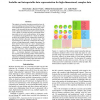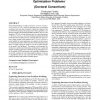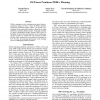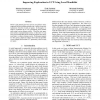AAAI
2015
9 years 9 months ago
2015
The majority of machine learning research has been focused on building models and inference techniques with sound mathematical properties and cutting edge performance. Little atte...
AAAI
2015
9 years 9 months ago
2015
In the proposed thesis, we study Distributed Constraint Optimization Problems (DCOPs), which are problems where several agents coordinate with each other to optimize a global cost...
AAAI
2015
9 years 9 months ago
2015
Unlike unsupervised approaches such as autoencoders that learn to reconstruct their inputs, this paper introduces an alternative approach to unsupervised feature learning called d...
AAAI
2015
9 years 9 months ago
2015
Heuristic search is a state-of-the-art approach to classical planning. Several heuristic families were developed over the years to automatically estimate goal distance information...
AAAI
2015
9 years 9 months ago
2015
Human computation or crowdsourcing involves joint inference of the ground-truth-answers and the workerabilities by optimizing an objective function, for instance, by maximizing th...
AAAI
2015
9 years 9 months ago
2015
In many learning tasks with structural properties, structural sparsity methods help induce sparse models, usually leading to better interpretability and higher generalization perf...
AAAI
2015
9 years 9 months ago
2015
PDDL+ planning involves reasoning about mixed discretecontinuous change over time. Nearly all PDDL+ planners assume that continuous change is linear. We present a new technique th...
AAAI
2015
2015
SCRAM: Scalable Collision-avoiding Role Assignment with Minimal-Makespan for Formational Positioning
9 years 9 months ago
Teams of mobile robots often need to divide up subtasks efficiently. In spatial domains, a key criterion for doing so may depend on distances between robots and the subtasks’ l...
AAAI
2015
9 years 9 months ago
2015
Monte Carlo planning has been proven successful in many sequential decision-making settings, but it suffers from poor exploration when the rewards are sparse. In this paper, we im...
AAAI
2015
9 years 9 months ago
2015
Automatic citation recommendation can be very useful for authoring a paper and is an AI-complete problem due to the challenge of bridging the semantic gap between citation context...




